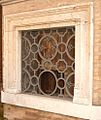Baby hatch facts for kids
A baby hatch (also called foundling wheel) is a system where parents can leave infants for adoption anonymously. Such systems were in use since the Middle Ages. Baby hatches are usually installed at hospitals. There, mothers or fathers can put their newborn baby into the hatch. The hatches are usually in hospitals or social centers or churches and consist of a door or flap in an outside wall which opens onto a soft bed, heated or at least insulated. Sensors in the bed alert carers when a baby has been put in it so that they can come and take care of the child. It will be cared for by hospital staff. If it is not claimed within a given time period, it will be given up for adoption. These hatches are popular in Germany and Pakistan.
One reason baby hatches are used is because some mothers can't take care of their babies.
History
Baby hatches started in medieval times. They started in 1198 in Italy. They became more popular after the 17th century. They became less popular during the 19th century.
Today only some countries have baby hatches. In others they are illegal.
Other pages
Images for kids
-
Baby hatch called "BabyBox" in the Czech Republic
-
Baby hatch in Poland. The label OKNO ŻYCIA means "Window of Life"
-
Foundling wheel at the "Ospedale di Santo Spirito" in Rome
-
Foundling wheel at the "Ospedale degli Innocenti" in Florence
-
Foundling Hospital in London
-
Baby hatch in Rabat, Malta
-
Baby hatch in Ludwigshafen, Germany
-
Baby hatch in Warsaw, Poland, 2018











